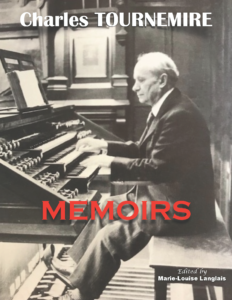AGO & Organ News
December 2020 TAO Feature Article
The Parish of
Our Lady of Fatima
(Paróquia Nossa Senhora de Fátima das Furnas da Tijuca)
Rio de Janeiro, Brazil
Lewtak Pipe Organ Builders, Inc.
By Lance G. Hill

A little bit of humanity begins this article. I first met Tom Lewtak while he was a graduate organ student at the State University of New York at Binghamton. We became friends immediately, and my wife and I became the godparents to one of his sons. The friendship has endured now for 27 years! In the meantime, I was honored to witness and discuss the many points of the development and construction of this particular organ, marveling at the skill and artistry of the Lewtak team. I wish to give the reader the perspective of a person familiar with the firm from the time of its conception—Lewtak Pipe Organ Builders will celebrate its 20th anniversary in 2021—and also to present the viewpoint of someone who is a lifelong professional involved in the technical domain of the musical world.
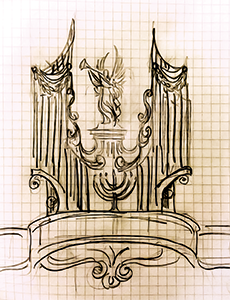
It all began in 2013 when a group of students was giving a concert on the Tannenberg organ at the Home Moravian Church in Old Salem, North Carolina. Afterward, one student from East Carolina University approached Tom Lewtak, mentioning that he was Brazilian and wondering if Lewtak Pipe Organ Builders would be interested in building an organ for his friend, a priest. Tom recounts: “Dr. Kris Rizzotto, a fine organist and composer, had no idea that our casual conversation might result in our shop undertaking this unusual organ.” After going through various twists and turns, and after building three other new instruments, work on what they call the “Brazil” organ continued at a slow but consistent pace. Seven years later, the organ is now ready.
While the project commenced in the fall of 2014, the time of Tom’s trip to see the church in Rio de Janeiro, it also saw the priest being transferred to another church, and thus, in a truly remarkable twist, the whole project moving with the priest. The original case design was prepared for a different church, one with much ornamentation in the Brazilian rococo style. The new location is a considerably smaller Portuguese missionary-style building with much less inner ornamentation and opulence, one that Mr. Lewtak deemed to be more suitable for the size of the organ. The physical space for the instrument, however, was greatly limited, thus requiring the builder to redesign the organ case and its facade in order to fit into the new church. The redesign occurred after many of the original ornaments were already made.

The Brazil organ is the smallest that Lewtak Pipe Organ Builders has ever constructed. It boasts a modest ten stops and twelve ranks of pipes. This naturally makes each stop that much more important. Everything counts, and each stop has a significant impact on the ensemble. Every rank was voiced with ultimate care to provide the individual flavor in addition to the proper blend with other stops. Quality was considered far more important than quantity. The size was dictated by the church’s dimensions, but primarily by the budget. New pipe organs remain a rarity in Brazil, partly because of difficult economic times.
The first sketch of the facade was jotted on a piece of scrap paper by Father Sergio Muniz, the pastor of Our Lady of Fatima Parish, during dinner in Rio. His initial idea prevailed, and the refined version became a faithful rendering of the priest’s concepts. Due to the lack of funds, the organ was built slowly. There was difficulty in time-paying, and therefore many other projects took precedence. In many ways, it was one of the most difficult ventures ever attempted by the shop because of the considerable spread in time.
The organ is a tracker, with both the key action and the stop action operated via mechanical linkage. Only two items in the organ were equipped with electricity: the blower and lights above the music rack. The construction benefited from the firm’s ultramodern machinery, with many parts of the organ, including the cabinet and facade, crafted using the CNC machine and laser cutters. Having this capability in-house allowed them to push the envelope right from the design stage. They let their imaginations venture into territories considered off-limits simply because of the difficulty in achieving the results. What used to be regarded as budget-breaking propositions are now within reach at a modest cost.
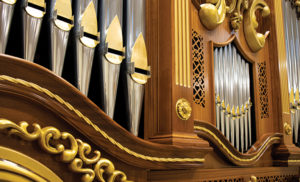
Worth mentioning is Lewtak’s obsessive attention to detail, often with complete disregard for the time, effort, and cost needed to attain the proper result. This is especially true when it comes to tonal finishing, which often takes many months after the organ is deemed playable. The builder’s clients rave about the quality they receive, a most important ingredient for any business wishing to flourish and endure. Time teaches one over the years to only use the best materials obtainable for the interior and exterior.
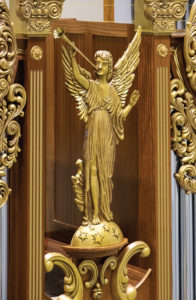
The ornaments were handmade by Tom Lewtak’s brother Paul, who lives in Poland and is an accomplished sculptor. They took him four months to create, after which they were shipped over to the shop in North Carolina. In this complicated process, the original ornaments were sculpted in clay. A mold was then created into which epoxy resin was later poured. After curing, each ornament was artistically painted to achieve the desired effect. All this for one reason: In the Brazilian climate, wood-eating bugs quickly devour anything made from the soft wood normally used for these kinds of ornaments. The drawknobs for the organ’s stops are made from rosewood and have inserts from genuine Baltic amber—just a touch of Tom’s Polish roots coming through, since he has seen amber jewelry everywhere in his native city of Gdańsk. Amber remains highly prized for its uniqueness and intrinsic beauty. The facade pipe mouths are gilded with 24-karat gold, and so are the twisted ropes visible in the moldings on the case. The entire facade is made of solid sapele, an African wood with an exceptionally attractive grain pattern. No expense was spared. Due to the design change in the midst of the project, the company had leftover ornaments and decided to place them in the back of the organ case and above the music desk and keyboards.

The country of Brazil is indeed fortunate to have this glorious instrument with both its musical capabilities and its extraordinary appearance. Being destined for South America, made in North America by an organbuilder with strong European roots, it is truly a global effort, one that will greatly enhance the sacred liturgies of Father Muniz and his parish.
A wealth of information about the builder, this project, and others is available on Lewtak’s web portal.
Lance G. Hill is a classical music radio broadcaster and piano technician for the State University of New York–Binghamton.
Photography: Kacper Lewtak
I Am AGO
Welcome to I am AGO, where members share what their AGO membership uniquely means to them. Want to join in? Please email a photo of yourself with one sentence about what you find special about your membership.
Send an email to Elizabeth George, Director of Member Engagement & Chapter Relations.
African-American Organ Music: A Roundtable Discussion and Live Q&A
The AGO is excited to invite you to attend the following special presentation: African-American Organ Music: A Roundtable Discussion Followed by a Live Q&A.
Join the discussion with panelists:
Adolphus Hailstork
Evelyn Simpson-Curenton
David Hurd
Mickey Thomas Terry
Mark Lawson
Date: Tuesday,September 8, 2020
View the discussion on YouTube at 7:30 pm EDT by clicking here
Attend the Zoom AGO Post Discussion at 8:30 pm EDT by clicking here
Presented in cooperation with MorningStar Music Publishers.
Memoirs
The AGO is pleased to provide a link to the digital publication of the selected memoirs of Charles Tournemire in English, edited by Marie-Louise Langlais, translated by Susan Landale.
“In 2014, I edited the French long version of Tournemire’s Memoirs, but I then had the idea that an English translation of this text, limited to material relating to music and the world of the organ and organists, would be useful and welcomed. This is that work.” –Marie-Louise Langlais.
Click here to read Memoirs by Charles Tournemire.
Paris, Monday July 27, 2020
TO : American Guild of Organists
James Thomashower, Executive Director
Bill Valentine, Director of Information, Technology and Digital Communications
Dear Sirs,
My sincere thanks to the AGO, this great association that provides constant
support to organists and the organ world. It has enabled The Memoirs of Charles
Tournemire to appear here on the internet, for free, in my edited version,
translated into English.
One can thus get an idea of the way that Tournemire viewed his own work, his
personal life, his contemporaries, and the historical period in which he lived. This
great composer, who was born 150 years ago and who died tragically at the
beginning of World War II, was one of the major figures of the 1930s, a
particularly rich period in the history of the organ in France, a period whose
importance and influence have never dimmed.
The date of this publication of Charles Tournemire Memoirs coincides with that
of an important Conference in honor of Vierne and Tournemire, scheduled for
presentation at The Peabody Conservatory of the Johns Hopkins University in
Baltimore, MD, but unfortunately postponed because of the Covid-19 pandemic.
Marie-Louise Langlais, Ph.D.
OrganFest 2020 Performances Live On!
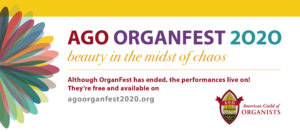
We hope you enjoyed the program for the AGO’s inaugural virtual OrganFest, which was held July 20 – 24, 2020. Details can be found at https://agoorganfest2020.org.
AGO OrganFest 2020 may have ended, but the performances live on! We are continuing to accept donations to help AGO members who have suffered financial hardships and cannot afford to renew their membership.
Make a Donation to Support an AGO Member. Please donate here.
The archived broadcast for each day’s program may be accessed at the links on the OrganFest 2020 website below:
Rising Star Performances may be accessed on the following page of the OrganFest 2020 website:
PipeTalks by presenters originally scheduled for the Atlanta 2020 convention are viewable here on the OrganFest 2020 website:
